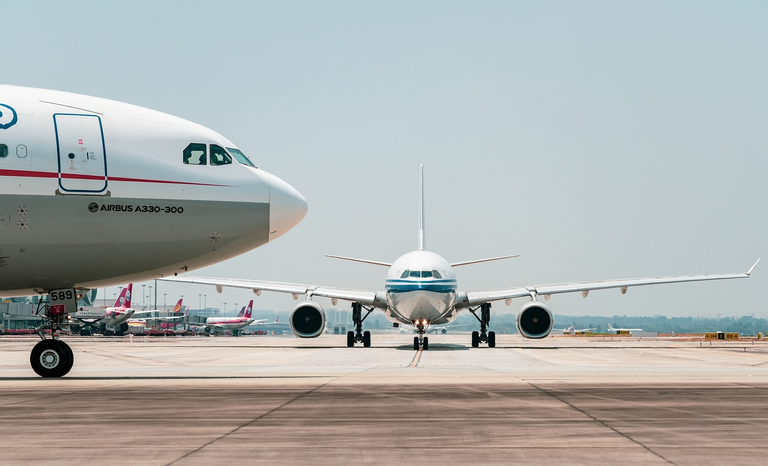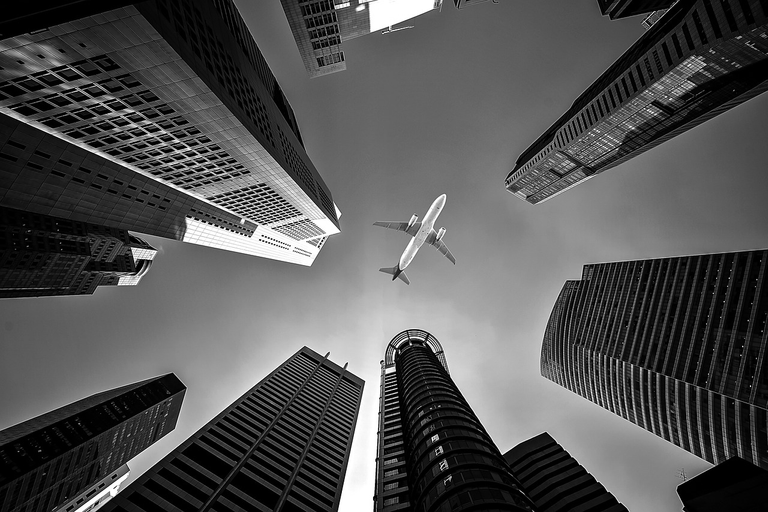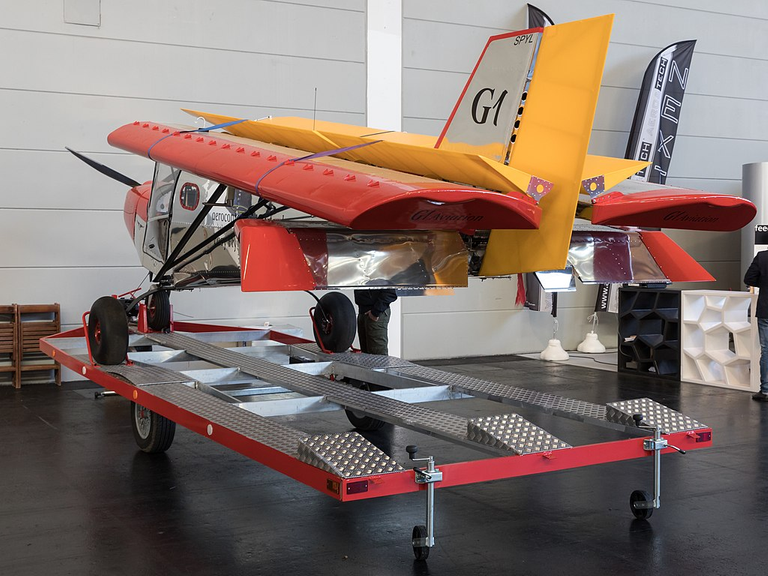Flying Towards a Greener Future: Addressing the Environmental Effects of Air Travel

Image from Pixabay
Because it facilitates communication and trade on a worldwide scale, the aviation industry plays a crucial role in the transportation sector. Still, we can't deny aviation's environmental costs. This article describes the many ways in which aviation harms the natural world and argues that the aviation industry must adopt more eco-friendly policies if it is to survive.
Air travel is a major contributor to greenhouse gas emissions due to the combustion of jet fuel in aeroplane engines. Greenhouse gases like carbon dioxide (CO2) are emitted into the environment when jet fuel is consumed. Large amounts of carbon dioxide are released into the atmosphere due to the high frequency of flights, the duration of trips, and the increasing demand for air travel.
The aviation sector's large carbon dioxide emissions contribute significantly to global warming. Carbon dioxide (CO2) can trap heat in the Earth's atmosphere, making it a greenhouse gas. Because of this, it contributes to the issue of global warming. Carbon dioxide is discharged into the atmosphere when jet fuel is consumed. The emission of carbon dioxide is a significant contributor to the global warming crisis. Long-term carbon dioxide emissions worsen the greenhouse effect, which might have devastating consequences for Earth.
Aircraft are responsible for between 2 and 3 percent of global carbon emissions, according to the International Civil Aviation Organisation (ICAO). Emissions from the aviation sector have increased by more than 100% annually over the past two decades, and that trend is forecast to continue. When considering the whole aviation industry's impact on global warming—including CO2 emissions and other factors—a more nuanced picture emerges.
Emissions from aircraft produce large quantities of carbon dioxide, which in turn contribute to global warming and the accompanying climatic change. Severe weather, higher sea levels, disturbance of ecological systems, and impacts on human health are only some of the consequences of the aforementioned occurrences. The potential consequences of climate change make it imperative that we immediately address the harm that air travel causes to our planet.
Many individuals are concerned about the effects of air pollution on the natural world and human health.
Emissions from planes often include nitrogen oxides (NOx). They are produced in the high-temperature combustion processes of aircraft engines. Nitrogen oxides (NOx) are a common and pervasive cause of air pollution.
Ozone at ground level is created when volatile organic compounds (VOCs) and nitrogen oxides (NOx) react under the sun. As a result, ground-level ozone is produced, an important component of smog. Research has connected exposure to ground-level ozone to respiratory issues and concluded that it contributes to air pollution.
NOx contributes to the development of PM2.5, which is harmful to people's lung health when combined with other pollutants. Inhaling PM2.5 can exacerbate respiratory issues, including asthma and coughing.
Nitric acid, the main component of acid rain, is produced when nitrogen oxide (NOx) emissions combine with other air pollutants and water. Many ecosystems have suffered damage from acid rain, particularly in terms of water and soil quality.
Producing an excessive amount of noise that alters the natural acoustic environment is the definition of noise pollution.
The aircraft industry is a major contributor to noise pollution. Takeoffs, landings, and ground traffic noise can have a negative impact on the health of people, animals, and those who live close to airports. The consequences of noise pollution in the aviation industry are discussed in the following paragraphs:
Noise pollution from aeroplanes is harmful to human health. Long-term exposure to loud noises can cause stress, irritability, and sleep disturbances. Noise pollution has been linked to hearing loss, hypertension, and even heart disease in the long run. Aeroplane noise has also been linked to academic difficulties and lower performance in school for youngsters. The best way to safeguard the public is to eliminate all sources of aviation noise.
Noise from planes taking off and landing near runways may have a significant impact on local residents' quality of life. The noise that these activities produce is the main cause of this. This might make everyday life more difficult, threaten outdoor recreation areas, and reduce people's standard of living. Too much noise can lower property values, which can have an adverse effect on the economy. Communities work to reduce airport noise by implementing noise abatement measures and participating in airport development procedures.
Aircraft noise may have a negative impact on ecosystems and wildlife. Noise can alter the behaviour of species that are particularly sensitive to it, such as birds. This may cause shifts in their mating and communication patterns, as well as their foraging strategies. The disruption described above may upset the equilibrium of the entire ecosystem, leading to a decrease in population. Eliminating noise pollution and safeguarding animal habitats are two of the most effective ways to support biodiversity and ecosystems.
Noise from aviation takeoffs and landings can disrupt residents' ability to obtain a restful night's sleep when runways are located nearby. Not getting enough sleep and the health concerns that come with it are just two of the many issues that can arise from late-night activities and early-morning departures. One's health, productivity, and mental well-being all take a hit when one consistently skimps on sleep.
Schools close to airports are particularly vulnerable to the negative impacts of aircraft noise. Classroom performance may suffer if students are unable to focus on their work because of excessive background noise. All of these factors may make a classroom less conducive to learning, which in turn may affect students' performance. It may be possible to mitigate the disruptive impacts of aviation noise in schools by installing soundproofing materials and developing noise reduction strategies.
Because of the noise, airports often restrict nearby property usage. Excessive noise levels may impede the development of residential, commercial, and recreational areas close to airports. The value of the land might decrease, and there could be conflicts over its usage if this happens. Finding a happy medium between the airport's operational requirements and the development of the surrounding region depends on effective noise pollution management.
Aeroplane noise may be mitigated in many ways, including through the use of novel technology, the adoption of more efficient practises, and tighter regulation of land use. As a result, the aviation industry has been investigating noise-cancelling technology and working to develop quieter aircraft and engines. To aid communities in coping with the consequences of aviation noise, land use planning should include noise-sensitive areas and establish suitable zoning restrictions. Noise pollution from aircraft requires concerted efforts from governments, regulatory agencies, airport owners, and local populations.
The implications for land use of the anticipated expansion of the airport and related infrastructure

Image from Pixabay
There are a variety of environmental and social impacts associated with the expansion of airports and the accompanying infrastructure. The expansion of airports is critical to fostering economic growth and facilitating better communication in the aviation industry. However, excellent caution must be taken and sound management strategies implemented to lessen the likelihood of unintended consequences arising from this expansion. Some considerations regarding airport expansion and its impact on nearby land use are as follows:
As airports expand, they typically have to clear enormous swaths of land, often including forests and wetlands. Because of this, these natural habitats will no longer exist. Important ecosystems and species are often lost as a result of the clearing process. Destroying natural habitats can disrupt the lives of native plants and animals, push wildlife populations to disperse, and accelerate the rate at which biodiversity is being lost.
There is a risk that natural ecosystems may be disrupted as a result of airport construction of runways, taxiways, terminals, and other man-made infrastructure. These alterations have created new hazards and physical barriers that may slow the growth of some species. Because of habitat loss, communication across regions becomes more difficult. This causes populations to become isolated, which hinders gene flow, migration, and species survival.
Airports have the potential to obstruct bird migration routes when constructed in areas frequented by these creatures. This is a serious issue for many types of birds. The construction of airports and the associated infrastructure has the potential to alter the usual migratory patterns of several species, with consequences for reproduction and diet. The disruption in question may have a multitude of consequences for natural systems, including altering the social organisation of animals and, as a result, reducing their numbers.
More noise and light pollution are often the result of longer runways and more planes. Planes can be disruptive to local residents and wildlife when they take off, land, or taxi around the airport. Noise has a negative impact on people's quality of life because it interferes with their sleep, makes them irritable and anxious, and makes it challenging to focus. Those near airports will find this to be especially true. Airport lighting systems may contribute to light pollution. This has the potential to alter the habits of nocturnal creatures and harm the habitats they rely on.
Extending runways typically requires repurposing land that was once used for something else, like a farm. Lots of cropland might be lost in the transition, which would be bad for the local food supply. Altering land for airport infrastructure also increases the risk of urban expansion, which compounds the problem of vanishing ecosystems and diminishing green spaces.
As airports expand, more water is required for activities like construction, landscaping, and basic operations. A greater water demand will result from this. There may be a strain on regional water resources as demand rises, especially in areas where water scarcity is already an issue. Airport activities that use large amounts of water may deplete adjacent aquifers, making it more difficult for other businesses and wildlife to get water.
Social displacement and its effects on surrounding communities warrant discussion in the context of airport expansion. The expansion of airport runways may force some residents to relocate. Possible course revision: residents may be forced to relocate due to noise pollution, safety concerns, or government property seizure. Displacement can have significant social and economic repercussions. Some of these repercussions include disruptions to local means of subsistence and the loss of houses and social networks.
Airport construction plans should incorporate sustainable land-use policies. Habitat preservation, noise and light pollution mitigation, and public participation are all examples. Environmental impact studies, land use planning, and stakeholder input may help ensure that airport expansion is carried out responsibly and sustainably.
To address the environmental harm that infrastructure projects like airport construction and others cause, sustainable solutions are crucial. Reduce environmental impact and boost long-term profitability by adopting eco-friendly practises in the aviation sector. The following eco-friendly choices should be considered:

Image from Wikipedia
Airport expansion may benefit from sensible land use planning practises, which also reduce negative impacts on the environment. To minimise potential harm to fragile ecosystems, wildlife habitats, and agriculturally significant regions, the procedure entails a thorough examination of potential locations for new airports or expansions. The study also considers the noise level, air quality, and accessibility of alternative modes of transit to and from the airport.
Sustainable design and construction practises might reduce the negative impact of airport expansion projects on the environment. The planet would benefit from this. The aforementioned actions include the incorporation of renewable energy sources and the implementation of energy-efficient construction practises. In addition, airport infrastructure may be developed and operated in an environmentally responsible manner by adhering to green construction laws and standards like LEED (Leadership in Energy and Environmental Design).
It is crucial to give conservation and restoration of biodiversity priority in airport development projects. The expansion of airports has the potential to disrupt and perhaps eradicate entire ecosystems. Wildlife corridors, more green spaces, and habitat restoration programmes can all help. Developing connections with local conservation groups and professionals can make it simpler to identify and implement practical strategies for protecting wildlife.
Noise reduction methods assist in mitigating the environmental impact of aircraft operations by decreasing noise and emissions. The use of noise-reducing technology in aircraft engines, the implementation of noise-reduction techniques during takeoff and landing, and the construction of airports with noise barriers and insulation are all viable options for reducing aviation noise pollution. The use of cleaner and more efficient aircraft technology and the promotion of sustainable aviation fuels (SAF) may significantly reduce carbon pollution and air quality close to airports.
Safe methods of water and resource management are crucial to the efficient operation of airports. The demand for freshwater can be lowered by implementing water-saving measures like collecting rainfall and recycling trash. Sustainable resource management may be aided by adopting energy-efficient technology, minimising energy use, and advocating for waste reduction and recycling programmes.
Successful sustainable practises require participation from and partnerships with local communities, environmental organisations, and other relevant entities. Airport expansion may be made more holistic and ecologically conscious if stakeholders are consulted, their feedback is sought, and their worries are addressed. Working together with neighbouring communities may streamline the process of gaining assistance from each other and open doors to opportunities for mutual gains, such as the development of jobs and environmentally friendly tourism initiatives.
If the aviation sector is going to adopt greener practises, research and innovation must continue unabated. The recommended actions include investing in R&D to advance emission-free aircraft technology, exploring alternative propulsion systems, including electric and hybrid-electric engines, and producing carbon-neutral, sustainable aviation fuels. Agreements between academic institutions, private companies, and the government to conduct research might spur innovation and hasten the spread of eco-friendly methods.
The aviation sector may reduce the negative environmental impacts of airport expansion by adopting sustainable practises that provide long-term environmental stability, safeguard local animal populations, and ensure the health of surrounding communities and ecosystems.
References
- Timperley, J. (n.d.). The fastest way aviation could cut its carbon emissions. The Fastest Way Aviation Could Cut Its Carbon Emissions - BBC Future. https://www.bbc.com/future/article/20210525-how-aviation-is-reducing-its-climate-emissions
- https://www.nationalgeographic.com/travel/article/greener-air-travel-will-depend-on-these-emerging-technologies/
- https://cen.acs.org/environment/sustainability/Airlines-want-make-flight-sustainable/99/i32. (n.d.). https://cen.acs.org/environment/sustainability/Airlines-want-make-flight-sustainable/99/i32
- Forum, W. E. (2021, July 2). The Future Of Flying Is Closer Than Ever-Sustainable Fuel Is The Key. Forbes. https://www.forbes.com/sites/worldeconomicforum/2021/07/02/the-future-of-flying-is-closer-than-ever-sustainable-fuel-is-the-key/
- McInnis, K. (2022, April 22). The airlines taking steps to become more sustainable — and you can fly them | CNN Underscored. CNN Underscored. https://www.cnn.com/cnn-underscored/travel/sustainable-airlines-2022
- How the Airlines Plan to Achieve a Greener Flying Future. (2021, April 27). AFAR Media. https://www.afar.com/magazine/how-airlines-are-working-to-reduce-their-carbon-footprint
- Climate change and flying: what share of global CO2 emissions come from aviation? (2020, October 22). Our World in Data. https://ourworldindata.org/co2-emissions-from-aviation
- https://cen.acs.org/environment/sustainability/Airlines-want-make-flight-sustainable/99/i32. (n.d.). https://cen.acs.org/environment/sustainability/Airlines-want-make-flight-sustainable/99/i32
- https://cen.acs.org/environment/sustainability/Airlines-want-make-flight-sustainable/99/i32. (n.d.). https://cen.acs.org/environment/sustainability/Airlines-want-make-flight-sustainable/99/i32


Air travel has been one of the things that have been increasing the rate of sir pollution and it is getting increasing more due to the fact that people are also trying to travel outside the country
You're right bro. If this rate would be considered and mitigation should be upheld, then we won't have much to worry about the environment
Thanks for your contribution to the STEMsocial community. Feel free to join us on discord to get to know the rest of us!
Please consider delegating to the @stemsocial account (85% of the curation rewards are returned).
You may also include @stemsocial as a beneficiary of the rewards of this post to get a stronger support.